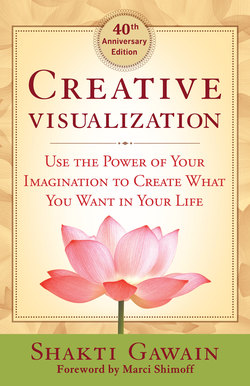Читать книгу Creative Visualization - Shakti Gawain - Страница 8
ОглавлениеI read Creative Visualization for the first time as a starry-eyed college junior in 1978. I vividly remember the day I propped myself up against the trunk of a towering oak and felt like time stood still as I devoured each word, convinced that by some cosmic intersection of fates, Shakti Gawain was speaking directly to me. I was excited to apply the concepts and practices to my college life, and as I did, a whole new world of possibilities opened up to me.
At the time, I’d been feeling tired, unhappy, and weighted down by the extra twenty-five pounds I’d been lugging around since I was thirteen years old. I knew I wanted to be fit, healthy, and full of energy and joy, but nothing I’d tried before had worked.
So I decided to use the techniques in Creative Visualization to set out to transform myself. I began running every day, and as I ran, I visualized a thin, happy, energetic version of myself. I imagined how I would feel and act in a healthy and fit body. I pictured the surprised smiles on my parents’ faces when they’d pick me up at the airport for summer break.
Sure enough, within four months, I had lost those twenty-five pounds, and I felt like a different person — I was full of energy, healthy, and excited about life. My family was stunned. I was elated. And that experience forever transformed my ideas about what was possible when I applied the power of my thoughts to my life.
Creative Visualization became my guide — my go-to source for inspiration, affirmation, and empowerment. It helped me embrace dreams I hadn’t known I had permission to dream.
After college, I continued to apply the book’s wisdom with great success in every area of my personal and professional life. I’ve also shared these visualization processes in the trainings I’ve led for audiences in over fifty countries throughout the world. My gratitude for Shakti has lived on in my heart as I’ve witnessed, year after year, the powerful impact creative visualization has had on the members of my audiences and my private clients of every ethnicity, nationality, gender, and age.
I could never have imagined that forty years after first reading it, I would be asked to write the foreword to this stunning anniversary edition of Creative Visualization, the book that opened up whole new worlds for me so many decades ago.
Many of my friends and colleagues have also credited Creative Visualization for their life-changing realizations and epiphanies over the years. As my dear friend and mentor Jack Canfield, cocreator of the Chicken Soup for the Soul series, shared with me recently, “That book was like nothing I’d ever read before. It’s what got me started using visualization in my personal life and in my teachings.” My assistant, a quintessential millennial, says it’s “her favorite book ever.” And my business partner recently told me that when her mom passed away at the age of ninety-two, Creative Visualization was the only book on her nightstand.
When it was first published, Creative Visualization was viewed as groundbreaking, provocative, and outside the ordinary. Today it’s considered to be one of the foundational works of the personal growth movement, and its concepts have gained wide acceptance in mainstream society. Olympic athletes, business executives, students, and retirees alike use these techniques to reach their goals, manifest their dreams, and live more rewarding lives. It was the forerunner to so many offerings about our power to create, including the widely successful film and book The Secret that I contributed to.
Today science is confirming the beneficial effects of visualization, as studies substantiate the power of thought to create or influence our reality. Research on the way neurons fire shows that to our brains, there’s little or no difference between a powerful visualization and the actual experience.
As I read this beautiful anniversary edition, I was struck by how much — and at the same time, how little — the world has changed since that fateful day I sat under the oak tree on my college campus. In the original 1978 edition, there’s a list of what most people truly want: “love, fulfilment, enjoyment, satisfying relationships, rewarding work, self-expression, health, beauty, prosperity, inner peace, and harmony.” Although the world is outwardly a very different place in this new millennium, the things we want most deeply haven’t changed at all.
And while people can certainly use creative visualization to focus on outer goals — a new car, a fabulous job, a passionate marriage — I deeply appreciate the perspective offered in this book: that a purpose-filled and rewarding outer life must begin with a rich inner connection to soul, Source, and self. Shakti Gawain teaches that happiness is about more than simply creating the material things you want — it’s about creating a life full of meaning, spiritual richness, and abundant joy.
On behalf of the millions of people around the world whose lives you’ve touched and transformed, I thank you, Shakti, for the gift of this seminal treasure. Your words have helped us shape lives of greater peace, joy, and fulfilment.
And congratulations to you, the reader, for inviting this book into your life. May its beautiful wisdom lead you to the most amazing life you can imagine.
With a vision of joy, happiness, and love for you,
Marci Shimoff, #1 New York Times–bestselling author of Happy for No Reason and Chicken Soup for the Woman’s Soul
